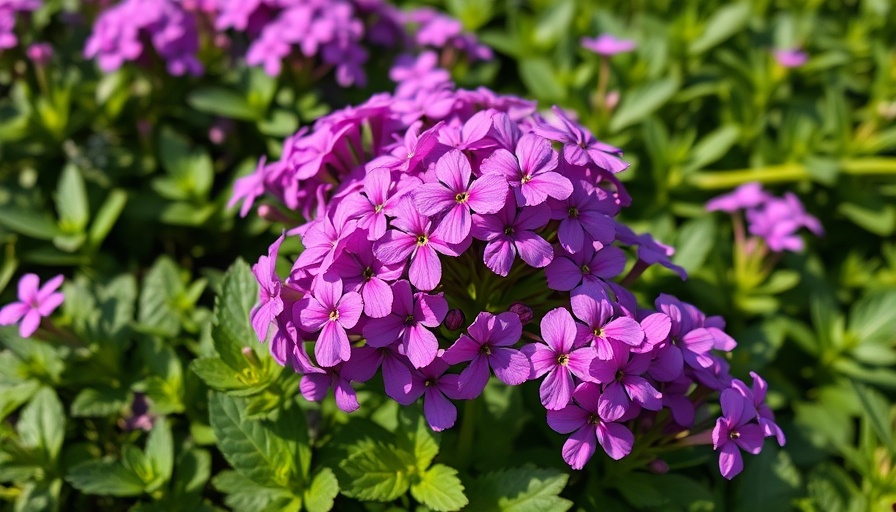
Discover the Beauty of Spring Phlox
As winter fades and the first hint of spring emerges, garden enthusiasts eagerly anticipate the vibrant blooms that punctuate their landscapes. Among these early favorites are three captivating species of spring phlox: woodland phlox, creeping phlox, and moss phlox. These hardy perennials offer not just visual delight, but also a significant boost to local ecosystems by attracting pollinators, making them a must-have for any garden.
What Makes Spring Phlox Stand Out?
Spring phlox are renowned for their ability to bring color to the garden when many other plants are still awakening from winter dormancy. Their blooming period, which begins early in the season and extends into early summer, provides essential food for pollinators that emerge during this time. This makes phlox not only a beautiful addition to your garden but also a critical component of ecological health.
Identifying the Three Species of Spring Phlox
Each species of spring phlox has unique characteristics and ideal growing conditions:
- Woodland Phlox (Phlox divaricata): This variety thrives in dappled sunlight or high shade, making it perfect for planting under deciduous trees. With flowering stems reaching up to 14 inches, colors can vary from white to pink, and even cerulean blue. Complement woodland phlox with shade-loving companions like lady ferns or astilbe to create a lush, layered garden effect.
- Creeping Phlox (Phlox stolonifera): As its name suggests, creeping phlox spreads through horizontal stems, forming a dense mat of color between 6 to 12 inches tall. It works beautifully as a ground cover and can adapt to shadier areas, protecting soil and preventing erosion. This phlox perfectly embodies the laid-back charm of an impressionistic garden carpet.
- Moss Phlox (Phlox subulata): Sometimes confused with creeping phlox, moss phlox features an abundance of blooms and is renowned for its low-growing habit. This species is perfect for rock gardens or as a border plant, providing a colorful edge to pathways and beds.
Embrace the Environmental Benefits
In growing phlox, gardeners contribute significantly to local biodiversity. These natives serve as vital food sources for bees, butterflies, and other pollinators that are crucial in maintaining the health of our ecosystems. With increasing urban development, incorporating native plants like phlox into our gardens helps restore habitats and promote ecological resilience.
Practical Tips for Planting and Care
When establishing spring phlox in your garden, consider the following practical tips to ensure they thrive:
- Soil Quality: Phlox prefer well-draining soil that can retain some moisture. Incorporate organic matter to improve soil structure and fertility.
- Sunlight Requirements: Position woodland phlox in shaded areas, whereas creeping and moss phlox will enjoy sunny spots as well. Monitor your garden’s light patterns and choose the best placements accordingly.
- Watering: New plantings will require regular watering to establish roots. Once established, phlox are relatively drought-tolerant.
Creating a Stunning Spring Garden
Imagine a garden bursting with color where woodland phlox nestles beneath shady trees, creeping phlox weaves its way across a rockery, and moss phlox flanks sunny paths. Mixing these varieties not only enhances aesthetic appeal but also creates a habitat that attracts various pollinators. To maximize enjoyment of your garden, consider integrating garden art or decorative elements that complement the vibrant colors of the phlox flowers.
Final Thoughts: Why You Should Choose Spring Phlox
Add spring phlox to your garden arsenal for a reliable burst of spring color that transitions beautifully into summer. These plants are resilient, low-maintenance, and support local wildlife—making them an environmentally-friendly choice that enhances the beauty of your outdoor spaces.
Call to Action: Start Your Spring Garden Today!
Now that you know the enchanting qualities of spring phlox and how to integrate them into your garden, it’s time to take action. Whether it’s your front yard, backyard, or balcony, these blooms can transform your outdoor space. Visit a local nursery or explore online garden shops to find the perfect phlox varieties that suit your growing conditions. Embrace the joy of gardening this spring and watch your landscape flourish!
 Add Row
Add Row  Add
Add 




Write A Comment